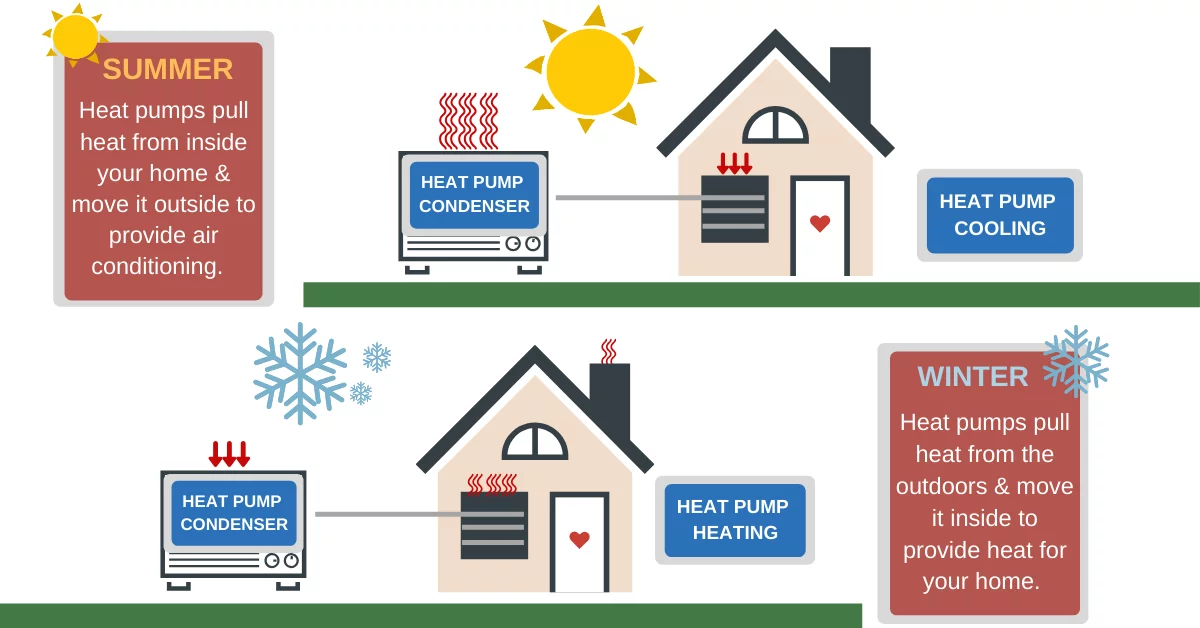
The concept of a heat pump is confusing to most. It is not a furnace, but it is capable of warming your home. It’s not an air conditioner, but it keeps your home cool.
Below is a quick rundown of what this mystifying system is, how it works, and how it is actually beneficial for you to have one at your home.
First of all, what is a heat pump?
Simply put, a heat pump is an electrical device that takes heat from one place and transfers it to another. It is part of the central heating and cooling system. It uses outside air to heat a home in the colder months and cool a home in the hotter months. They do not generate heat, they move it.
How do heat pumps work?
The system consists of two main components: an outdoor heat pump and an indoor air handler. Think of it as a transporter. It is constantly moving warm or cool air from one place to another, where it is needed, depending on the time of year and the desired temperature of a home. During the colder months, a heat pump takes outside heat and transfer it inside. And, in the warmer months, it does the reverse effect and acts like an air conditioner, removing heat from the home.
Heat pumps transfer heat by circulating a substance called a refrigerant through a cycle of evaporation and condensation. A compressor (similar to the motor of a car) pumps the refrigerant between two heat exchanger coils. In one coil, the refrigerant is evaporated at low pressure and absorbs heat from its surroundings. The refrigerant is then compressed en route to the other coil, where it condenses at high pressure. At this point, it releases the heat it absorbed earlier in the cycle.
Refrigerators and air conditioners are both good examples of heat pumps operating only in the cooling mode. A refrigerator is essentially an insulated box with a heat pump system connected to it. The evaporator coil is located inside the box, usually in the freezer compartment. Heat is absorbed from this location and transferred outside, usually behind or underneath the unit where the condenser coil is located. Similarly, an air conditioner transfers heat from inside the house to the outdoors.
The heat pump cycle is fully reversible, and heat pumps can provide year-round climate control for your home – heating in winter and cooling and dehumidifying in summer. Since the ground and air outside always contain some sort of heat, a heat pump can supply heat to a house even on cold winter days.
What is the benefit of having a heat pump?
Since a heat pump only uses electricity for power rather than generating heat, it is substantially more efficient. Whereas, using electric baseboard or space heaters, the amount of heat generated is proportional to the amount of electricity used: one unit of heat per unit of 100% electricity.
With a heat pump, the rate goes up drastically because the electricity consumed is only used to power up the two fans (evaporator and condenser), compressor, and pump heat outside and bring into your home. Due to this, heat pumps are capable of providing more than 3 units of heat for every unit of electricity – making the efficiency rate 300%. This will also reduce your home’s carbon footprint.
Need help with your heat pump?
Having issues with your heat pump? Whether you need affordable heat pump repair services or a new heat pump installation, give the experts at Carolina Comfort Air a call at (919)-879-2106.
